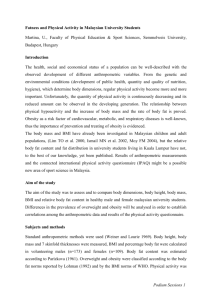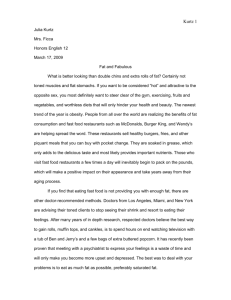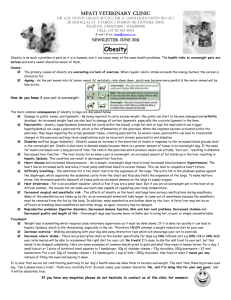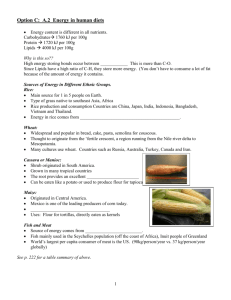The United States of Obesity - National Education Policy Center
advertisement
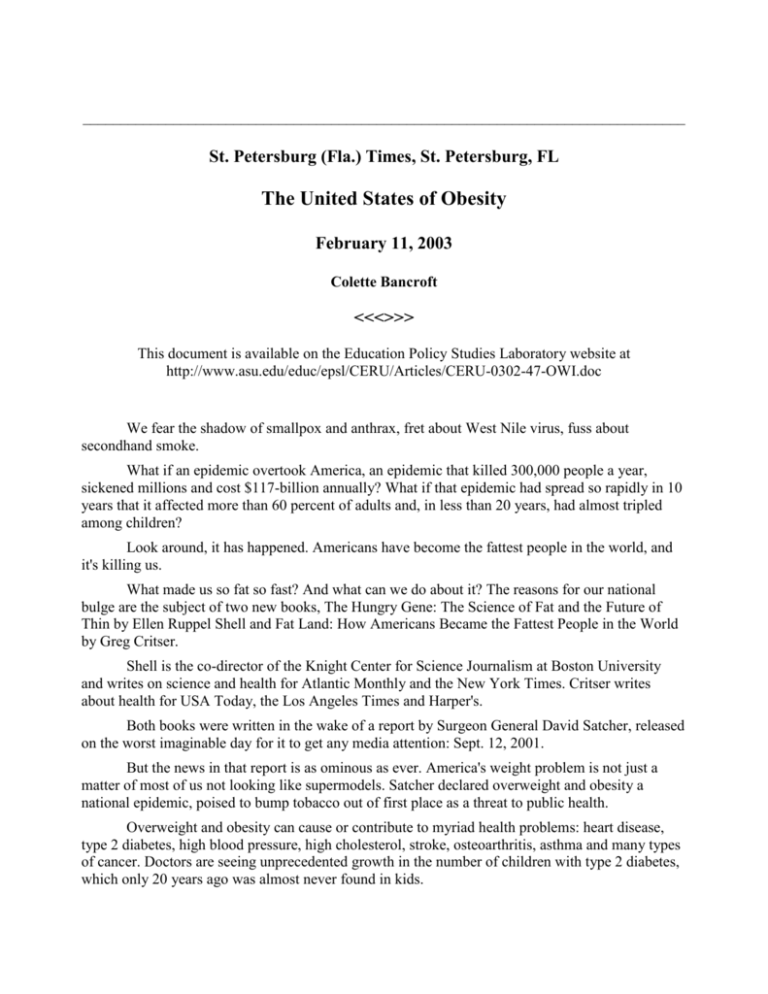
________________________________________________________________________________ St. Petersburg (Fla.) Times, St. Petersburg, FL The United States of Obesity February 11, 2003 Colette Bancroft <<<>>> This document is available on the Education Policy Studies Laboratory website at http://www.asu.edu/educ/epsl/CERU/Articles/CERU-0302-47-OWI.doc We fear the shadow of smallpox and anthrax, fret about West Nile virus, fuss about secondhand smoke. What if an epidemic overtook America, an epidemic that killed 300,000 people a year, sickened millions and cost $117-billion annually? What if that epidemic had spread so rapidly in 10 years that it affected more than 60 percent of adults and, in less than 20 years, had almost tripled among children? Look around, it has happened. Americans have become the fattest people in the world, and it's killing us. What made us so fat so fast? And what can we do about it? The reasons for our national bulge are the subject of two new books, The Hungry Gene: The Science of Fat and the Future of Thin by Ellen Ruppel Shell and Fat Land: How Americans Became the Fattest People in the World by Greg Critser. Shell is the co-director of the Knight Center for Science Journalism at Boston University and writes on science and health for Atlantic Monthly and the New York Times. Critser writes about health for USA Today, the Los Angeles Times and Harper's. Both books were written in the wake of a report by Surgeon General David Satcher, released on the worst imaginable day for it to get any media attention: Sept. 12, 2001. But the news in that report is as ominous as ever. America's weight problem is not just a matter of most of us not looking like supermodels. Satcher declared overweight and obesity a national epidemic, poised to bump tobacco out of first place as a threat to public health. Overweight and obesity can cause or contribute to myriad health problems: heart disease, type 2 diabetes, high blood pressure, high cholesterol, stroke, osteoarthritis, asthma and many types of cancer. Doctors are seeing unprecedented growth in the number of children with type 2 diabetes, which only 20 years ago was almost never found in kids. Perhaps most alarming is how quickly the numbers have grown. According to the Centers for Disease Control and Prevention, only four states had obesity rates above 15 percent in 1991. By 2000, 49 states did. The increases cut across age, gender, race and income lines throughout the U.S. population. An unprecedented weight gain How did this happen, and so quickly? There have always been fat people, but so many people becoming overweight in such a short time is unprecedented in human history. There are obvious targets of blame. On the same day in January, a lawsuit against McDonald's on behalf of obese children was dismissed by a federal judge who left the door open for the suit to be refiled, calling some of the chain's food "McFrankenstein creations," and the Journal of the American Medical Association published a study showing that average portion sizes have increased significantly at fast food chains, sit-down restaurants and at home during the past 25 years. But, as Shell and Critser make clear, fast food is only part of the reason Americans have become the fattest people on Earth. We live amid a confluence of many changes in our diet and environment that feed that expansion. And those changes may well make the next generation of children even fatter. The short version is we eat much more and exercise much less than we did 20, even 10 years ago, a sure-fire formula for weight gain. But there are medical, educational, corporate, cultural and even political forces fattening us up, and many of them are explored in these books. Shell focuses on research into the scientific mechanisms of weight gain and potential ways to reverse it. One common theory is that fatness is genetic. That's partly right. Research shows that the potential for getting fat is indeed genetic - for all of us. As a species, we evolved to survive in cycles of feast and famine, mostly the latter. For most of human history, the people who got fat the quickest had a survival advantage, so they passed their genes along to us. Researchers call it the thrifty gene, although there is no single gene that controls weight. In fact, the body's systems for controlling weight are so amazingly complex that scientists are just beginning to figure them out and are a long way from being able to manipulate them. For millennia, the thrifty genotype served our ancestors well. But for the past few decades, times have been so good they're killing a lot of us. Instead of storing fat during brief periods of plenty and burning it off in longer, leaner times, we just keep storing. Lean times don't get much longer than a 10-minute wait in the drive-through. The thrifty genotype has become a liability because of the way we live. Critser quotes James O. Hill, a physiologist who studies obesity and says it's "a normal response to the American environment." "If obesity is left unchecked," Hill says, "almost all Americans will be overweight by 2050." More TV, less exercise Not everything making us fat is in our kitchens. That hypnotic box in the living room has a lot to answer for. Critser points out three interrelated trends: "One, that most Americans are sedentary; two, that many feel they do not have the time to exercise; and three, that the average adult watches about four hours of television a day." Not only does TV keep us sitting on our duffs, it has also "merged parent and child into one seamless inactivity bubble - a bubble filled with billion-dollar cues to eat, even when one was not hungry." The causal relationship was made clear in a 1994 CDC study of 4,063 children: The more TV kids watched, the less they exercised and the more likely they were to be overweight or obese. Add video games and computer use to TV time, and you get a perfect environment for growing a fat nation. As screen time has increased, physical education programs in schools have withered. Budget cuts have reduced or eliminated organized PE, and many schools have even gotten rid of recess. Those kinds of cuts have hit hardest in the poorest school districts, and that is part of another factor Critser addresses: obesity as a class problem. Although increases in overweight affect every level of society, minorities and the poor are more likely to be obese. The main reason, Critser says, is that fat-larded, sugar-charged, supersized fast food and convenience food are relatively cheap and easy. Fresh fruits and vegetables, whole grains and lean meats are more expensive and perishable and take more time to prepare. But two factors related to education cut across class lines, Critser writes. Most of us are confused about how and how much we should exercise, and about what and how much we should eat. He details the wildly erratic history of exercise theory, from the successful President's Council on Physical Fitness in the late 1950s and '60s to studies - now in question - in the '90s that suggested people could stay fit with three 10-minute bouts of mild exercise a day. Most research on exercise, he points out, is done on affluent white males with excellent access to medical care - not exactly a representative population. Needed: some education As inconsistent as the advice we get on exercise may be, our information about nutrition may be even less useful. Schools vary widely in what they teach kids about healthful eating in the classroom, but the real lessons come in the cafeteria, and they're often toxic. Critser and Shell condemn in no uncertain terms the invasion of school cafeterias by soft drink pouring contracts and fast food chains. Even more insidious is junk food advertising in the form of "sponsored educational materials" such as a nutrition curriculum published by McDonald's, math lessons using Domino's Pizza graphics and reading texts that teach first-graders to recognize M&Ms logos. All of this translates to not much real nutrition information and a lot of advertising. Shell adds up the federal government's total annual expenditures for education about healthful eating and obesity prevention and comes up with $9-million. The initial phase of a new ad campaign for Milky Way bars had a budget of $25-million. Another part of the puzzle of what is making us fat is an offshoot of cultural politics. As Critser writes, as a result of the sensitivity politics born in the '70s, particularly feminism's focus on attitudes toward body image, it has become much less acceptable to stigmatize overweight people. That's particularly true of overweight children. Many parents and teachers hesitate to limit what kids eat or press them to exercise for fear it will damage their self-esteem. Certainly it can be harmful to push unrealistically thin body images on children. But, Critser points out, eating disorders such as anorexia and bulimia affect only a fraction of the number of people whose health is threatened by overweight. But even parents who try to control what their kids eat may not know just how bad some foods are. Some of the ingredients in tiny type in those long lists on the package label pack more punch to the paunch than we're aware of. Critser gives us the history of high-fructose corn syrup, a ubiquitous sweetener that's a main ingredient in most soft drinks and used in breakfast cereals, cookies, ice cream, energy bars, convenience foods and more. It contributes about 9 percent of the average American's daily calorie intake and about 20 percent of the average child's. The problem is that scientists are finding that high-fructose corn syrup is not just another sugar. Recent research has shown that it is metabolized by the body differently from other sugars in such a way that it not only increases the risk of diabetes but may increase the body's tendency to store fat. In other words, high-fructose corn syrup is not only a major calorie source; it may be a fatmaking machine. Science searches for a fix Scientists are responding to the fattening of America, and so are corporations. Shell details the research into a hormone called leptin, which first looked to be the magic bullet of obesity cures. The team that discovered it got an initial payment of $20-million from the drug company that hoped to develop it. Leptin turned out not to be a solution but only a biochemical baby step toward one. "Eating is too central an activity to be turned off by a single neurochemical switch," Shell writes. So, the intense competition goes on, even though, she writes, "The surge in the past decade of diet drugs has been accompanied by the greatest surge of obesity in history." Shell takes a look at Meridia, which raises blood pressure in some users (lowering blood pressure is one of the main medical reasons to lose weight) and may cause memory loss. Then there's Xenical, which prevents the body from absorbing fat and discourages consumption of fat. Sounds good, until you read the side effects, which can be worse after fatty meals: "gas with oily discharge, increased bowel movements, an urgent need to have them and an inability to control them." For that, you pay about $6 a day, lose on average less than 10 percent of body weight and, in most cases, gain it back when you stop using the drug. Weight loss drugs are not the only pharmaceutical bonanza from the spread of the American waistline. Critser writes that in 1999, Eli Lilly opened the largest plant dedicated to production of a single drug in industry history. The drug is insulin, for diabetes, and Lilly's sales of it are growing 24 percent a year. Case dismissed? Maybe not The medical industry isn't the only one fattening on the epidemic. The decade in which we grew so fat also saw an enormous proliferation of low-fat, low-cal, sugar-free food and drinks and a boom for the health club industry. Critser describes the fashion industry's response: retooling and renaming sizes. "What was once a regular cut was now a slim cut. . . . The unspoken reality of all these new cuts (easy fit, loose fit) . . . was this: The new cuts were in reality bigger sizes, without the bigger numbers." But Shell and Critser conclude that everyone is selling us all these diet drugs and baggy-fit jeans because someone else is selling us too much food. And they conclude that the fast food industry is a major villain. "The fast food industry has managed to disassociate food from its primary purpose," Shell writes. "The food it sells is meant to divert us. That many of these foods offer little in the way of actual nutrition seems to matter not a whit." What's more, she says, "Fast food creations have indelibly changed our concept of portion size," and larger portions make larger Americans. Lawsuits like the one against McDonald's may seem laughable. But, Critser points out, suits against Big Tobacco seemed laughable 20 years ago, when the argument was that smokers knew the dangers and were responsible for their own fates. A strong factor in the legal triumphs over Big Tobacco was proof that the industry had marketed its products to children. Lawyers argued that kids couldn't make judgments about tobacco's dangers. Fast food does vastly more marketing to children than tobacco ever did. Tobacco had to do it sneakily, but fast food corporations freely admit that kids are their primary advertising targets. Shell talks to manufacturers who make toys for fast food kids' meals and finds the toys often cost so much that no profit is made on the meals. But the fast food companies know they're creating a lifelong consumer. They're also teaching kids distorted ideas about portion sizes. Critser describes a program for children with type 2 diabetes, all overweight, that trains the kids to eat more healthfully. When these kids are asked at the beginning to demonstrate what they consider a normal portion of food, he writes, "In most cases, the estimated serving size was at least three times" the healthful portion. Burger King's Big Kid's meal, which the company says it markets to "tweens ages 7 through 12," consists of a double cheeseburger, small fries and 16-ounce drink. It has 1,010 calories and 42 fat grams. The USDA recommended intake for an entire day for a child in that age range is 2,200 calories and 73 grams of fat. The judge who dismissed the McDonald's case, Robert Sweet, left the door open for the case to be refiled. He agreed that consumers are responsible for what they eat but questioned whether they get the information they need to make reasonable choices. He cited Chicken McNuggets as an example. "Rather than being merely chicken fried in a pan," he wrote, they are "a McFrankenstein creation of various elements not utilized by the home cook." McNuggets contain dozens of ingredients other than chicken, the judge wrote, and are fattier than McDonald's hamburgers: A hamburger has 10 grams of fat; a four-piece Chicken McNuggets serving has 13. The consumer who thinks chicken is a lower-fat choice at the McDonald's drivethrough for herself - or her kids - is wrong. Since the suit was dismissed a couple of weeks ago, McDonald's has retooled its Web site to make nutrition information easier to access (though those fat grams haven't changed). But lawsuits won't solve the epidemic of overweight. In proposing solutions, Shell and Critser focus most urgently on children, emphasizing that schools and parents must take back control of what kids eat and encourage them to be active. For adults, too, taking back control is key. It's a battle not only against our appetites, but against a food industry that cares about our wallets, not our waistlines, and spends billions to get us to spend more billions on food that may be killing us. "We are not losing the war on weight," Shell writes. "We have not begun to fight." Contact Colette Bancroft at bancroft@sptimes.com or (727) 893-8435. The Measure of Fat How do you know whether you're overweight? For years, overweight and obesity were defined in terms of percentage of pounds over an ideal body weight. But doctors and researchers now use the body mass index, a more accurate system that describes body weight relative to height and is strongly correlated with total body fat content in most adults. To calculate your BMI, multiply your weight in pounds by 700, then divide the result by your height in inches squared. For example, if you are 175 pounds and 5 feet 8 inches, multiply 175 by 700 to get 122,500, then divide that by 4624 (68 times 68) to get your BMI of 26.5. For an online BMI calculator, two Web sites: http://www.cdc.gov/nccdphp/ dnpa/bmi/calc-bmi.htm nhlbisupport.com/bmi/ bmicalc.htm A BMI of 18.5 to 24.9 indicates a healthy weight. A person with a BMI of 25 to 29.9 is overweight, and one with a BMI of 30 or above is obese. The BMI numbers apply to both men and women. Sources: Centers for Disease Control and Prevention, National Institutes of Health, WebMD.com


